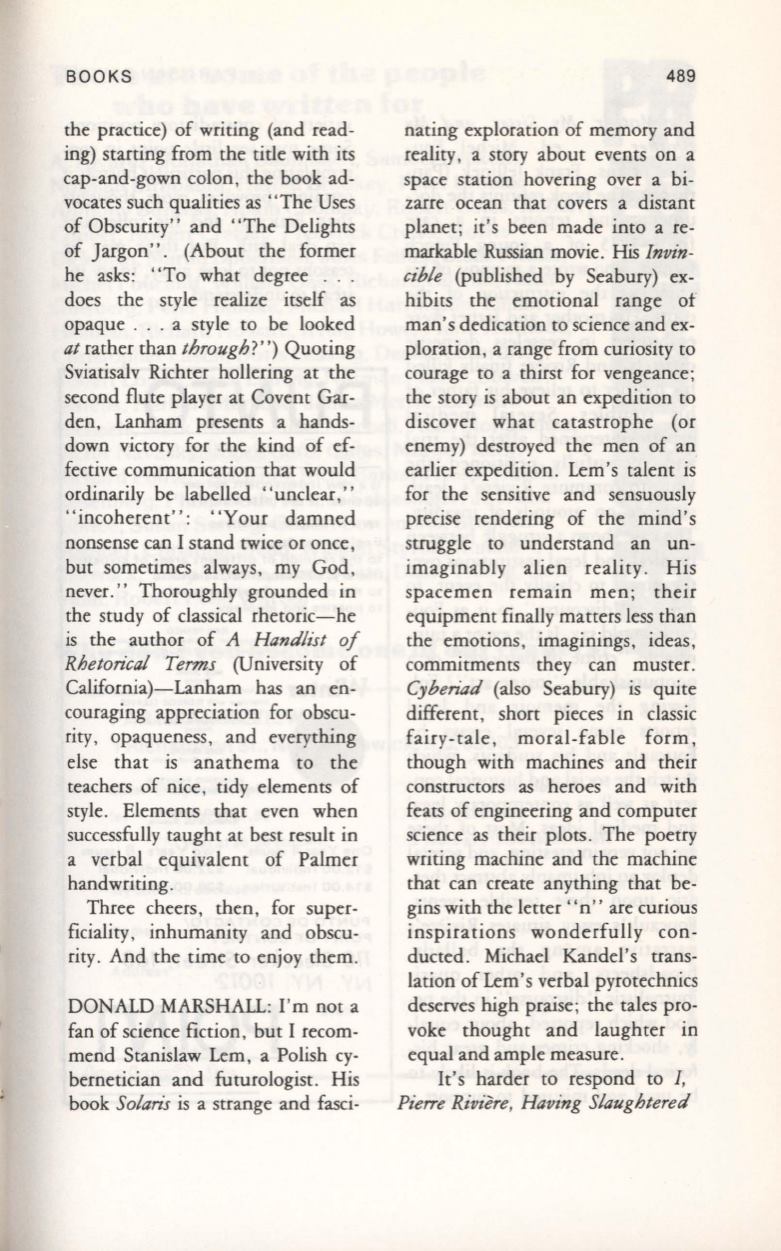
BOOKS
the practice) of writing (and read–
ing) starting from the title with its
cap-and-gown colon, the book ad–
vocates such qualities as " The Uses
of Obscurity" and "The Delights
of Jargon" . (About the former
he asks: "To what degree . ..
does the style realize itself as
opaque . . . a style to be looked
at
rather than
through?")
Quoting
Sviatisalv Richter hollering at the
second flute player at Covent Gar–
den, Lanham presents a hands–
down victory for the kind of ef–
fective communication that would
ordinarily be labelled "unclear,"
"incoherent" : "Your damned
nonsense can I stand twice or once,
but sometimes always, my God,
never." Thoroughly grounded in
the study of classical rhetoric-he
is the author of
A Handlist of
Rhetorical Terms
(University of
California)-Lanham has an en–
couraging appreciation for obscu–
rity , opaqueness, and everything
else that is anathema to the
teachers of nice, tidy elements of
style. Elements that even when
successfully taught at best result in
a verbal equivalent of Palmer
handwriting.
Three cheers, then, for super–
ficiality, inhumanity and obscu–
rity . And the time to enjoy them.
DONALD MARSHALL: I'm not a
fan of science fiction , but I recom–
mend Stanislaw Lem, a Polish cy–
bernetician and futurologist . His
book
Solaris
is a strange and fasci-
489
nating exploration of memory and
reality, a story about events on a
space station hovering over a bi–
zarre ocean that covers a distant
planet; it's been made into a re–
markable Russian movie. His
Invin–
cible
(published by Seabury) ex–
hibits the emotional range of
man's dedication to science and ex–
ploration, a range from curiosity to
courage to a thirst for vengeance;
the story is about an expedition to
discover what catastrophe (or
enemy) destroyed the men of an
earlier expedition. Lem's talent is
for the sensitive and sensuously
precise rendering of the mind's
struggle to understand an un–
imaginably alien reality . His
spacemen remain men; their
equipment finally matters less than
the emotions, imaginings, ideas,
commitments they can muster.
Cyberiad
(also Seabury) is quite
different, short pieces in classic
fairy-tale, moral-fable form,
though with machines and their
constructors as heroes and with
feats of engineering and computer
science as their plots. The poetry
writing machine and the machine
that can create anything that be–
gins with the letter" n" are curious
inspirations wonderfully con–
ducted. Michael Kandel's trans–
lation of Lem's verbal pyrotechnics
deserves high praise ; the tales pro–
voke thought and laughter in
equal and ample measure.
It's harder to respond to
I,
PieTTe Riviere, Having Slaughtered


